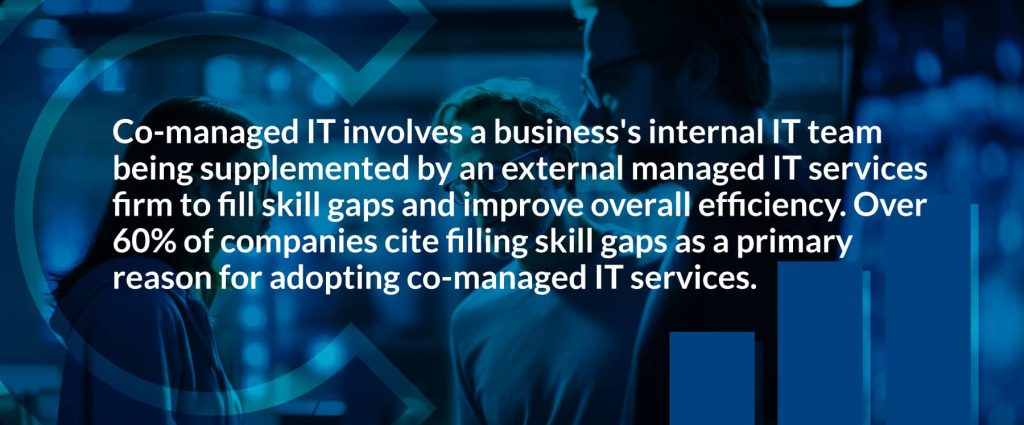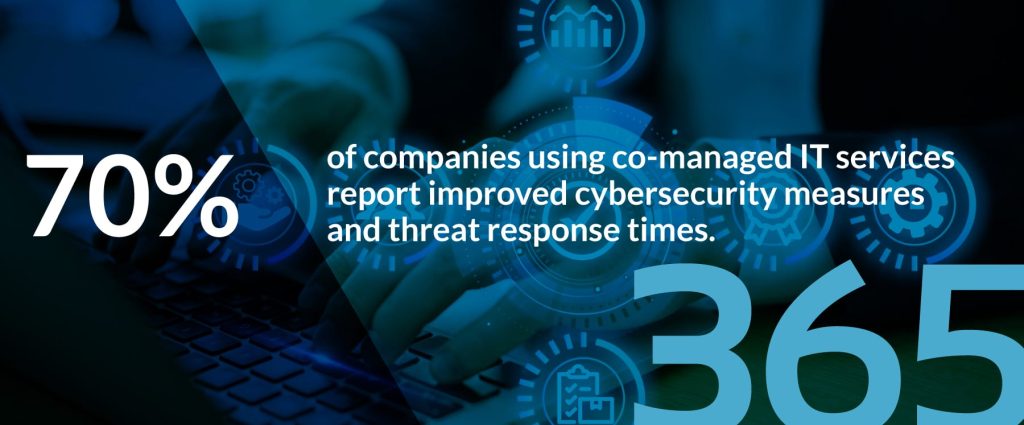For businesses, deciding between Co-Managed IT and Managed IT Services is about determining which services you truly need from your Managed IT Service Provider (MSP). At CloudScale365, we help business owners understand and decide which managed IT services arrangement will work best. Every business is unique, so a cookie-cutter, all-in-one Managed IT solution is only sometimes the best option.
In this article, we will help you understand your options when choosing a managed or co-managed IT solution model.
What are Co-managed IT Services, and how do they differ from Managed IT?
Managed IT Services Definition
Managed IT services is when the managed services provider fully takes care of the business’s technology. The outsourced managed IT services firm acts as the IT department. They are an integral part of the business’s team, participating in leadership and planning meetings. This enables them to provide timely and effective technology guidance and input.
Pros and Cons of Managed IT
| Pros | Cons |
| No responsibility | Higher costs |
| No need to maintain an internal IT team | Lower flexibility |
| Up-to-date IT systems | Less options for IT customization |
| Outsourcing all related to IT | Lower control |

Co-Managed IT Services Definition
Co-managed IT is where a business has an internal IT Department that is supplemented from the outside by a managed IT services firm. Sometimes, a company’s IT staff cannot perform all necessary roles due to time constraints or lack of skills. In this scenario, the managed IT service company supports the internal staff, filling in gaps and enhancing the overall performance and efficiency of the IT department.
Pros and Cons of Co-managed IT Services
| Pros | Cons |
| Higher Internal Control | Higher internal responsibility |
| Higher Flexibility | Higher internal costs |
| Better Utilization of the Internal IT Team | Shared responsibility |
| Cost-effective | |
| Highly skilful and experienced IT experts available always on demand | |
| Qualified mentorship and guidance |
What Do They Have in Common
Whether you choose Managed IT Services or Co-Managed IT Services, your business will benefit from essential baseline services designed to keep your technology infrastructure secure, efficient, and reliable. These foundational services include:
Security Software & Solutions
Comprehensive security measures to protect your business from cyber threats, including firewalls, antivirus programs, and intrusion detection systems. These solutions ensure your data and network remain safe from malicious attacks.
Software Patching
Regular updates and patches for your software applications to fix vulnerabilities, improve functionality, and enhance security. This proactive approach prevents security breaches and ensures that your systems run smoothly.
Data Backups
Automated and secure data backup solutions to safeguard your critical business information. Regular backups ensure that your data is protected and can be quickly restored in the event of data loss, hardware failure, or other emergencies.
Remote Access
Secure remote access capabilities that allow your employees to access company resources from anywhere. This flexibility supports remote work and ensures that your team can stay productive, even when working off-site.
Frequent Reporting
Managed IT and Co-Managed IT Services provide detailed reports on the status and performance of your IT infrastructure. These reports offer insights into system health, security issues, and overall IT performance, helping you make informed decisions.
Periodic IT Review Meetings
Regularly scheduled meetings with your MSP to review your IT environment, discuss upcoming needs, and plan for future technology initiatives. These meetings ensure that your IT strategy aligns with your business goals and that potential issues are addressed proactively.
Trusted Advisor
In both Managed IT and Co-Managed IT arrangements, the Managed Service Provider (MSP) serves as a trusted advisor. They provide expert guidance on technology decisions, helping you navigate the complexities of IT management and ensuring that your technology supports your business objectives.
How They Are Different
Managed IT Services include all IT services, and the client receives the results of those services. Co-managed IT services, however, provide only the services that the client needs, with some unique additions. A co-managed client gets access to technology tools, dashboards, ticketing systems, and documentation systems, as well as an IT mentor. These resources enable internal staff to perform their duties more efficiently.
| Aspect | Managed IT | Co-Managed IT |
| Definition | Complete outsourcing of IT operations to a third-party provider. | Shared responsibility between internal IT staff and an external provider. |
| IT Department | The MSP is the IT Department | Complements the IT Department |
| IT Staffing | The MSP provides all the resources needed | Supplements the internal IT Team |
| IT Strategy | The company has some targets. The MSP delivers infrastructure and complementary services and usually helps build the strategy end-to-end. | The internal IT team has ideas about what to achieve. The provider of co-managed services brings the missing expertise, usually specific and in-depth knowledge. It helps with strategy, delivers IT platforms, and acts as a trusted advisor with better experience. |
| IT Tools | Utilised by MSP only | Shared with the internal IT team |
| Network Maintenance | Network and infrastructure are always up-to-date | Shared with internal IT |
| Training/Mentoring | Businesses do not invest in IT learning | Training & mentoring the internal IT team if needed. Mentoring due to the bigger and more specific experience and skills |
| Control | The business has less control | The business has more control |
| Internal Costs | No internal IT costs | Higher internal IT costs |
| External Costs | Higher external/outsourced costs | Costs less than a fully managed IT |
| Expertise | More & higher expertise to call on | Shared responsibility for expertise. However, usually, the service providers have better knowledge, which would be costly and impossible for the business to have internally. |
| Customization | Standardized solutions, though providers may offer some customization. | Highly customizable, as internal staff can work with the provider to tailor solutions. |
| Focus | Allows the organization to focus on core business activities without IT distractions. | Enables internal IT to focus on strategic initiatives while leveraging external support for routine tasks. |
| Innovation | Access to innovative solutions and technologies from the provider. | Encourages innovation by combining internal insights with external advancements. |
When determining which model is best for you, you must consider your existing staff, IT needs, desired level of control, and level of responsibility.

Who Shall Consider Co-managed IT Solutions?
Co-managed IT services are ideal for various organizations looking to enhance their IT capabilities without completely outsourcing their IT functions.
Small to Medium-Sized Businesses (SMBs) often have limited IT staff and resources. Co-managed services provide access to a broader range of expertise and support without the need for extensive in-house hiring.
Growing Companies: Businesses experiencing rapid growth may need additional IT support to scale their operations efficiently. Co-managed services can offer the necessary resources and expertise to handle increased demand.
Organizations with Limited IT Expertise: Companies that lack specialized IT skills in areas such as cybersecurity, cloud computing, or advanced network management can benefit from the expertise provided by a co-managed IT service.
Businesses with Temporary IT Needs: Organizations undergoing significant changes, such as mergers, acquisitions, or major IT projects, may require additional IT support temporarily. Co-managed services can provide the needed support during these transitions.
Companies Seeking Cost Efficiency: Co-managed IT services can be more cost-effective than fully outsourcing IT or expanding in-house teams. This approach allows companies to optimize their IT budget by sharing responsibilities with a managed service provider (MSP).
Businesses Focused on Core Competencies: Organizations that prefer to focus on their core business activities and leave IT management to experts can use co-managed services to ensure their IT operations run smoothly without diverting attention from their primary business goals.
Industries with Compliance Requirements: Companies in regulated industries (e.g., healthcare, finance) that need to meet specific compliance standards can benefit from the expertise of co-managed IT services to ensure they adhere to relevant regulations and avoid penalties.
Organizations Looking for Enhanced Security: Businesses seeking to bolster their cybersecurity measures can leverage the specialized knowledge and tools provided by co-managed IT services to protect their data and systems more effectively.
Co-Managed IT Services and Fully Managed IT play vital roles in small and medium-sized businesses today. The best model depends on your business’s specific needs and circumstances. CloudScale365 can help you decide which model best supports your IT strategy and business growth. Contact us today to explore your options and find the right fit for your business!
 Broadwing Capital Acquires CloudScale365...
Broadwing Capital Acquires CloudScale365... 


